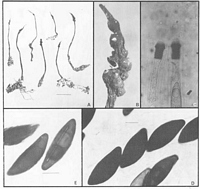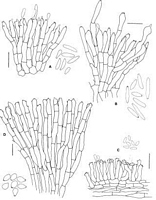|
 Xylaria theissenii var. macrospora Xylaria theissenii var. macrospora
BiostatusPresent in region - Indigenous. Endemic
Images (click to enlarge)
Caption: Fig. 19 Xylaria theissenii var. macrospora A, Stromata. B, Stromal surface. C, Ascal ring
(Melzer's reagent). D, Ascospores (M:elzer's reagent). E, Ascospores with germ slits
(Melzer's reagent). (PDD 44428, Lines A = 1 cm; C, D, E = 10 | 
Caption: Fig. 20 Xylaria anamorphs A, X. hypoxylon (PDD 45372 from nature). B, X. cf. berkeleyi
(PDD 44421 from culture). C, X. cf. filiformis (PDD 44321 from nature). D, X. theissenii
var. macro |
Description: Stromata: Stromata filiform; stipitate; 25-50 mm tall; 1-2 mm diam.; perithecia conspicuous, or almost completely exposed; ostioles lower than or more or less equal to stromatal surface; stromatal surface wrinkled; greenish, or dark brown (brown vinaceous); KOH-extractable pigments lacking; tissue below perithecia conspicuous, essentially homogeneous, white.
Perithecia: Perithecia more or less globose; 0.4-0.5 mm diam.
Asci: Stipe short with spores filling about two-thirds of ascus; amyloid ring higher than broad.
Ascospores: Ascospores 34-40 µm long; 13-14 µm wide; brown; 0-septate; in side view more or less equilateral, or inequilateral, flattened on one side, not curved; in face view elliptic; ends broadly rounded. Germ slit straight, less than spore-ength; on flattened side of spore. Perispore indehiscent in 10% KOH.
Article: Rogers, J.D.; Samuels, G.J. (1987) [1986]. Ascomycetes of New Zealand 8. Xylaria. New Zealand Journal of Botany 24(4): 615-650 (http://www.rsnz.org/publish/abstracts.php).
Description: Stromata solitary, simple, 2.5-5 cm long, tip at first conidiogenous and whip-like; filiform, 1-2 mm diam.,
surface olivaceous, wrinkled, fleshy; perithecia intercalary, nearly superficial,
pyriform, acute, 400-500 µm high x 400 µm wide. Internal tissue white, solid. Asci greater
than or equal to 280 µm total length x (11-)13-15( 20) µm, the sporiferous part (210-)217-250(-205) µm,
cylindrical; apical ring J+, cylindrical, 6-7 µm wide x 7-10(-12) µm high; 8-spored, ascospores uniseriate
with overlapping ends. Ascospores (31-)34-40(-42) x (9-)13-14(-16) µm, fusiform with subacute ends,
inequilateral, one side flat and the other side
rounded, dark brown, near opaque; slit 22-26 µm long, straight, parallel to long axis of the
ascospore. Conidiophores in vivo forming a compact paliade along the tip of the
conidiogenous stromata; palisade 50-100 µm deep; conidiogenous cells cylindrical, c. 4 µm
wide, straight, smooth, pale brown; conidiogenous loci terminal, leaving a 1 µm wide
refractive, frill-like abscission scar after conidial dehiscence. Conidia (4.0-)5.5-7.0 x 3.0-4.0
µm, subglobose to elliptical, tip sometimes acute, with a 0.5 µm, refractive basal frill, very
pale brown, smooth.
Habitat: HABITAT: On ground under living Nothofagus spp. and on rotten wood of Nothofagus
spp.
Distribution: DISTRIBUTION: NORTH ISLAND: Gisborne.
Notes: X. theissenii var. macrospora seems to differ from the typical variety chiefly in
the larger size of its ascospores. It has been found only in association with Nothofagus spp.
and might grow from living rootlets.
This variety is closely related to Xylaria taxonomic species 1 (see above).
|